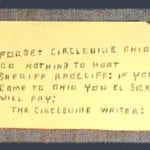 Crime
Crime  Crime
Crime  Technology
Technology 10 Hilariously Over-Engineered Solutions to Simple Problems
 Miscellaneous
Miscellaneous 10 Ironic News Stories Straight out of an Alanis Morissette Song
 Politics
Politics 10 Lesser-Known Far-Right Groups of the 21st Century
 History
History Ten Revealing Facts about Daily Domestic Life in the Old West
 Weird Stuff
Weird Stuff 10 Everyday Products Surprisingly Made by Inmates
 Movies and TV
Movies and TV 10 Actors Dragged out of Retirement for One Key Role
 Creepy
Creepy 10 Lesser-Known Shapeshifter Legends from Around the World
 Animals
Animals 10 Amazing Animal Tales from the Ancient World
 Gaming
Gaming 10 Game Characters Everyone Hated Playing
 Crime
Crime 10 Terrifying Serial Killers from Centuries Ago
 Technology
Technology 10 Hilariously Over-Engineered Solutions to Simple Problems
 Miscellaneous
Miscellaneous 10 Ironic News Stories Straight out of an Alanis Morissette Song
Who's Behind Listverse?

Jamie Frater
Head Editor
Jamie founded Listverse due to an insatiable desire to share fascinating, obscure, and bizarre facts. He has been a guest speaker on numerous national radio and television stations and is a five time published author.
More About Us Politics
Politics 10 Lesser-Known Far-Right Groups of the 21st Century
 History
History Ten Revealing Facts about Daily Domestic Life in the Old West
 Weird Stuff
Weird Stuff 10 Everyday Products Surprisingly Made by Inmates
 Movies and TV
Movies and TV 10 Actors Dragged out of Retirement for One Key Role
 Creepy
Creepy 10 Lesser-Known Shapeshifter Legends from Around the World
 Animals
Animals 10 Amazing Animal Tales from the Ancient World
 Gaming
Gaming 10 Game Characters Everyone Hated Playing
Ten Strange Facts About Ambergris
Ambergris is a solid, waxy, and very mysterious substance formed in the intestinal tracts of sperm whales. The name comes from the French “gray amber,” and the peculiar origins of ambergris and what it actually is have been debated for centuries.
Ambergris only forms in the intestinal tract of sperm whales and not in any other whale species. However, it is estimated that less than 10 percent of sperm whales form ambergris, which is believed to be a secretion of the bile duct. As squid beaks are often found embedded in ambergris, it is thought the substance forms as an aid to pass the hard, sharp, and indigestible beaks through the whales digestive tract.
Like wax, ambergris floats and is thus primarily found on beaches throughout the world. The Bahamas, Maldives, New Zealand, India, Kenya, and the Arabian coastlines of Yemen and Oman produce found ambergris. In the bygone days of the whaling industry, ambergris was sometimes found in the intestinal tracts of dead sperm whales as they were processed in whaling factories.
Related: 10 Bizarre Quirks Of Ocean Life Caught On Film
10 History
As a commodity traded in markets in various places around the world, ambergris has a history dating back thousands of years. It is recorded that the ancient Egyptians used ambergris as a medicinal substance and burned it as incense. Chinese thought it to be a kind of solidified dragon spittle that dragons drooled as they slept. No one was sure where it came from at this time, but everyone knew it was valuable.
For many people at this time, the mystery of its origins—the fact that ambergris could not be identified as coming from any specific plant or animal—was what made it valuable. For others, ambergris had purported medicinal properties. Many people wore a bouquet containing ambergris and herbs around the neck in a pomander, a latticed metal ball, during the Black Death in Europe as its subtle aroma was thought to mask the bad smells that were believed to be the source of the plague.
A recent academic study attempting to verify ambergris via chemical analysis revealed that several of the 40 or so samples tested were over 1 000 years old, having drifted through the world’s oceans perhaps for decades or, in some cases even, for centuries before washing ashore and being found on a beach and identified.[1]
9 Composition
Ambergris was only recently positively identified by DNA analysis as coming from the intestinal tracts of sperm whales. For centuries it was thought to be a form of whale vomit, regurgitated from the whale’s mouth and coming from a variety of whale species, but that has been proven false. Ambergris is excreted from the anus of the whale, not the mouth.
The waxiness of ambergris makes it float and makes it flammable. The presence of hard, sharp, black-colored squid beaks is a positive indicator that the substance may be ambergris. The flame test is a common test used to determine if a quantity of a substance found on a beach is, in fact, ambergris, but it is not considered actual proof.
The aroma test can also indicate if the substance is ambergris or not. But this is only conclusive if the person has extensive experience with ambergris, as it is considered nearly impossible to describe in words in any language exactly what ambergris smells like.
Ambergris is very similar to fecal matter when first expelled from sperm whales as a dark brown to black waxy slurry containing squid beaks. At this stage, it has little value. The prolonged aging process at sea lightens the color from almost black to brown to gray and, in rare cases, a shade of white. This aging process can take years and perhaps decades or longer, giving a subtle, incredibly complex aroma and other valuable qualities to the substance.[2]
8 Location
As ambergris is the exclusive product of sperm whales and no other whale or animal species, and the substance cannot be cultivated, created, or mined, for ambergris hunters, it would be reasonable to assume ambergris can be found where sperm whales are present.
But it is not so simple. Sperm whales can be found in every ocean, but not every sperm whale produces ambergris during its lifetime. Other factors like ocean currents and local storms determine where ambergris may finally wash up on a beach. This random drifting may take place for years, decades, or possibly centuries after the substance was excreted from a sperm whale.
Some of the hotspots where ambergris has been documented as found on beaches or in the near-shore waters include New Zealand, where sperm whales are known to be present, Sri Lanka, Brazil, Somalia, Kenya, Britain, Mozambique, Madagascar, The Bahamas, Indonesia, and many other locations can also result in the substance washing up on shore.
A recent find off the coast of Oman in the Arabian Sea was by three fishermen who pulled in a large chunk of aged gray-colored ambergris while fishing. It weighed over 80 kilograms (176 pounds) and had an estimated value of almost US $3 million.[3]
7 Finding
Over the centuries, there have been many different ways to find ambergris. Still, none of them can be called particularly successful as the substance has always been rare and hence, valuable. If a method had been found to increase the supply of natural ambergris, then there would be more available, and the price would go down, but this has not been the case.
Early Arab ambergris hunters on the coastlines of Oman and Yemen used specially trained camels to sniff out the substance from seaweed, dead fish, cuttlebones, and other detritus normally found on a beach of the Arabian Sea. The animals were taught to kneel on the sand when they found a piece.
Like truffles, another subtly aromatic substance in high demand, many modern ambergris hunters use dogs, which can find ambergris with their keen sense of smell. The challenge for the owner is, as with truffles, to keep the dog from immediately eating any ambergris they have found. But that comes with training and discipline from the owner, as a poorly-trained dog could quickly swallow a fortune in found ambergris.[4]
6 Color
Ambergris can have a wide range of colors, from jet black through rusty brown to almost white. Color is one of the key indicators of age and value, with the blackest ambergris, which is relatively fresh and has a strong smell of manure, at the lowest value on the international market. Black ambergris is considered to be nearly worthless.
It is during the lengthy aging process that the color of the ambergris changes, and the magic happens via oxidation, photochromic transformations, and other mysterious processes to produce value in the substance. No one knows exactly how this happens, but the color changes from black to rusty shades of brown to gray to a near-white after years, decades, or centuries at sea.
The oldest and usually the most valuable ambergris is a light gray to white in color, a gradual fading that has taken place over years or decades of random drifting in the oceans of the world. Several tested samples of ambergris have been proven to be hundreds of years old. Some have even been confirmed at over 1 000 years old, a prolonged period of aging at sea or lying undisturbed on an isolated beach.[5]
5 Notable People
As ambergris has been traded and used in various applications for centuries, many notable people have been associated with the substance as users or traders. The ancient Egyptians mentioned ambergris in hieroglyphic texts over three thousand years ago when it was burned as an incense.
Ambergris was a favorite of royalty across the European continent, with King Charles II of Britain said to enjoy grated ambergris over his morning scrambled eggs. Many people, including King Louis XIV of France and his wives and mistresses, drank small amounts of ambergris-laced wine and other drinks in the belief it was a powerful aphrodisiac and sexual enhancer, something like the Viagra of its day.
Ambergris was incorporated into edibles from ancient times, as recorded in the travel journals of the Muslim scholar and traveler Ibn Battuta, who noted ambergris was eaten as an aphrodisiac by men and as a fertility enhancer by women in ancient Persia and the Red Sea region of Arabia.[6]
4 Trade
Ambergris was traded widely throughout the ancient world by Egyptians, Greeks, and Romans around the Mediterranean Sea. Of Indonesian origin, “Ambar,” the Arab word for ambergris, made an appearance in Europe by the early Middle Ages via trade with the Muslim world.
As Venice rose in importance and wealth as a trading center for spices and luxury goods from the near and far east, one of the commodities bought and sold in the most lucrative market in medieval Europe was ambergris. The substance was a low-volume, high-value luxury commodity bought in Muslim cities in the Middle East like Alexandria and Gaza and shipped to Venice for resale. Ambergris was not a major trade item in Venice, but for centuries Venice was one of the only markets in Europe where it could be regularly found in any quantity.
The Portuguese were the first to import ambergris to Europe in significant quantities, having encountered the substance on their long voyages to India and the East Indies, starting with Vasco de Gama reaching the west coast of India in 1498. As these voyages often lasted for years, with many stops in coastal communities in west Africa, east Africa, and India, there was ample opportunity to trade for items of value, including this strange, waxy aromatic substance greatly valued by the local people. If trade terms could not be reached, the Portuguese would use their superiority in arms to take what they wanted, including ambergris.[7]
3 Perfume
The first recorded use of ambergris as a perfume enhancer was in the Arab emirate of Granada in Muslim Spain in the 10th century. “Ambar,” brought to Spain via North Africa, was not burned in the traditional manner as incense. Instead, it was used in the formulation of court perfumes as a binder and enhancer, a role it continues to play to this day for major perfume houses.
The effect of ambergris in perfume is similar to a pheromone. It acts on the hormonal system of men without actual physical contact, making any woman who wears an ambergris perfume inexplicably yet irresistibly attractive. Men are compelled to give such a woman their undivided attention and admiration and spend money without constraint to please their every whim. No wonder women like it!
The modern synthetic substitutes for natural ambergris made from plants are said to have the same effect. However, it is not proven, and many perfumeries still use the naturally-occurring ambergris, purchased from the open market when and where it is found. Then it is stockpiled for use, much as diamond merchants stockpile diamonds when available for later distribution.
While few perfume houses actually state they use natural ambergris in their perfumes, the continuing market for natural ambergris and the extremely high prices a piece of the highest quality ambergris commands on the market is indicative they do. Also, the leading artificial version of the active ingredient in ambergris, called Ambrox, is difficult to synthesize and expensive to buy in quantity, so there is little advantage to the perfume house in using a synthetic substitute.
Luxury perfume house Frater Perfumes by Listverse founder Jamie Frater uses natural New Zealand ambergris in a number of its perfumes.[8]
2 Legality
Ambergris is a product of animal origin, from whales, specifically from sperm whales, so it is restricted or illegal to possess or sell in various jurisdictions.
In the UK, New Zealand, and the European Union, possessing or selling ambergris is perfectly legal. It is classified as a product of animal origin from a protected species but is considered an excretion, similar in status to urine or feces, and therefore legal.
The situation is very different in the United States and Australia, where possession or trading in ambergris is banned with no exceptions. India also bans any possession or trading in ambergris, but the rule is widely flouted as ambergris of Indian origin is regularly sold in markets outside of India.
In the historic days of the whaling industry, ambergris was occasionally found in the intestinal tract of slaughtered sperm whales. However, most reputable dealers today certify their product as originating from “en flotte” or “floating” ambergris, meaning it was naturally excreted and found on a beach or in the sea.[9]
1 Value
Now we come to the nitty-gritty, which is value. So, what is it worth? Quite a lot, depending on the quantity and quality of the piece of ambergris.
The ambergris with the highest value is, generally speaking, the oldest—pale gray-colored, almost white, with a subtle aroma that may have been floating in the sea for years, decades, or, in rare cases, for centuries. The least valuable is the fresh ambergris, very dark in color with a strong odor of manure, which is nearly worthless.
As the trade is controlled by a small group of veteran dealers, they know their business and, of course, what is or is not ambergris, so people would be wasting their time trying to fake the stuff and sell it.
Most buyers of ambergris have a rigorous testing and authentication protocol with the current market price of about US $30 per gram for the highest quality pale gray ambergris, with the lower grades trading at US $20 to $25 per gram.
So put on your beachcomber shoes and hat, get out there and start looking on the nearest beach for the find of a lifetime.[10]








